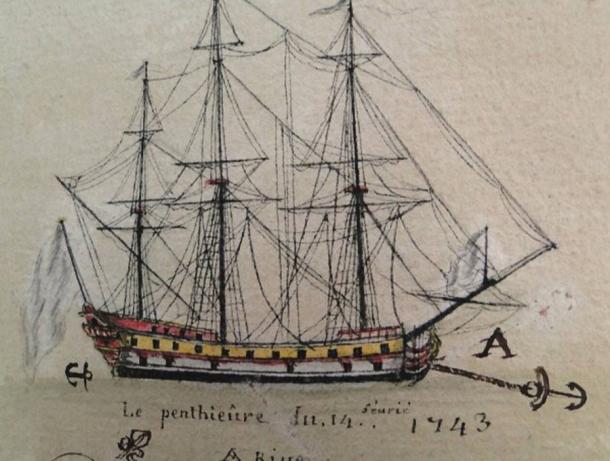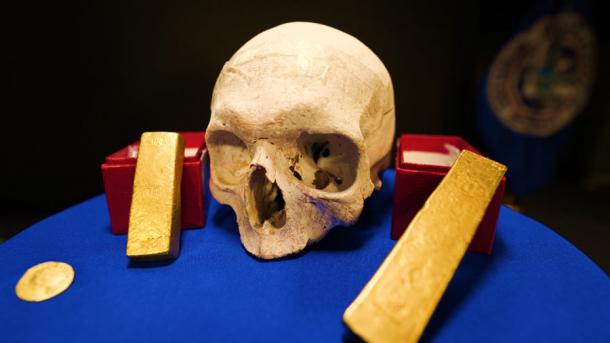Chinese Gold Ingots Stolen From 18th Century Shipwreck Have Been Returned
The United States government has just returned a collection of historically significant artifacts stolen by fortune hunters to the French government, to whom the artifacts rightfully belong according to international law. Included in this valuable bounty were five gold ingots inscribed with Chinese characters, which were manufactured and exchanged in China in the 18th century. These ingots were once used as a form of currency and had been in the possession of French East Indian Trading Company representatives when the ship they were traveling on sunk off the coast of France on December 3, 1746.
After being lost for more than two centuries, the gold ingots were “illegally” recovered from the bottom of the Atlantic Ocean by a team of divers who discovered the remains of the shipwreck in 1974. They were seized by agents from the Homeland Security Investigations arm of the United States Immigration and Customs Enforcement Agency in 2018, after they were put up for sale online by a California auction house.
On March 2, an official from Homeland Security Investigations returned the ingots and the other precious historical artifacts to the French ambassador of the United States at his residence in Washington, D. C.
"We are very grateful to the United States for the action taken by its services to return these artifacts," said ambassador Philippe Étienne, in a statement to the U.S. media. “It emphasizes the quality of cooperation between the French and American customs, police, and judicial services in the fight against trafficking in cultural property."

The Prince de Conty was a 600-ton ship, built in L'Orient in 1743, when it sank off the coast of France it was carrying the Chinese gold ingots and much more. (Gothenborg)
The Gold Ingots and the Treasure of the Prince de Conty
On December 3, 1746, the trading ship Prince de Conty was due to arrive at the port city of L’Orient, France, carrying a shipload of goods acquired from Nanjing, China. The ship was carrying many highly coveted items, including tea, Qing Dynasty porcelain, and approximately 100 gold ingots bearing Chinese inscriptions. These gold ingots would be worth 25,000 dollars (23,000 euros) each on today’s gold market, putting the total value of the shipment above the 2.5-million-dollar mark (2.3 million euros).
- The Revenge of Pirate Jeanne de Clisson, The Lioness of Brittany
- Mysterious Brittany Rock Inscription Finally Solved, Revealing Tragic Death
The Prince de Conty was just 10 miles from port when it sank, victimized by bad weather and rough seas. Nearly 200 men perished in the disaster, while only 45 managed to stay afloat long enough to be rescued. There were attempts to recover the ship’s cargo in the subsequent months and years, but all of these efforts were unsuccessful, and eventually salvage teams gave up the search.
The story of the Prince de Conty shipwreck became a local legend in France’s Brittany region. Over the years, amateur divers made many attempts to find the ship and recover its lost treasures. Finally, in 1974, a team of divers found the ship and its contents. Instead of reporting their discovery to the authorities, however, the divers retrieved the gold ingots and kept them for themselves (a decidedly illegal action).
Most of the illicitly obtained ingots were likely melted down before being sold, to hide the truth about their origin. However, at least five of the ingots were preserved intact, which could be seen as a minor miracle given their value as pure gold.
These five survivors were first seen publicly in 1999, when a woman living in Tampa, Florida contacted the producers of the PBS television program “Antiques Roadshow” and requested an appraisal for the ingots and for several pieces of Chinese porcelain that also likely came from the Prince de Conty. The woman was selected to appear on the program, and to cover her tracks she claimed the items in her possession had come from a shipwreck found off the coast of West Africa.

The Chinese gold ingots, a skull from the French catacombs, and a famous Roman coin, which were repatriated to France from the USA after a series of criminal investigations. Source: ICE Office of Public Affairs
She might have gotten away with this deception, if not for the efforts of Michel L’Hour, an official with France’s Underwater Archaeology Department. L’Hour’s job was that department was to identify and hunt down stolen antiquities, and when he heard the woman’s story on the show he became suspicious and decided to look into her claims.
During the program the woman showed a photograph of the gold ingots taken on the ocean floor, before they were salvaged. L’Hour was able to prove that some of the marine life seen in that picture could be found off the coast of France, but not off the coast of West Africa. Investigating further, he eventually discovered that the woman was the sister of the wife of one of the original dive team that had recovered the bounty from the Prince de Conty back in 1974 (their activities had been discovered and exposed years earlier, even though the treasures they’d looted had not been recovered).
Unfortunately, before L’Hour discovered the truth the woman apparently did find a buyer for the illicitly obtained ingots. L’Hour’s investigation may have driven them underground from that point because they were not seen again in public until 2018.
At that time they were suddenly listed for sale by a Santa Rosa, California auction house called Stephen Album Rare Coins, by the individuals who now had them in their possession. Presumably, these people thought enough time had passed that they could get away with putting the valuable gold ingots up for auction. But what they didn’t realize was that Michel L’Hour was still on the case, assisted by many colleagues who search internet auction sites all over the world looking for stolen artifacts listed for sale by private collectors.
After the Underwater Archaeology Research Department researchers recognized the ingots they contacted the United States government to request assistance. The ingots were recovered soon after during a Homeland Security Investigations raid, putting them in the hands of legitimate authorities for the first time since they’d been recovered from the bottom of the Atlantic Ocean 44 years earlier.

The signing of the artifacts’ repatriation agreement in Washington DC between USA and French officials. (ICE Office of Public Affairs)
Celebrating a Story with a Happy Ending
Before returning the items, authorities in the United States had to choose between competing claims, as both the French and Chinese governments said the gold ingots should be returned to them. Eventually, arbitrators with the U.S. Immigration and Customs Enforcement Agency decided in favor of the French, stating that the 13-ounce (368-gram) gold bars were a “common form of currency” in the 1740s and would therefore rightfully belong to whoever was holding them at the time of the shipwreck.
With the last of the legal hurdles cleared, Homeland Security Investigations was finally able to return the recovered artifacts to the French this year. In addition to the gold ingots, they also returned two other items seized during separate government raids targeting illicit antiquities dealers.
One of these recovered artifacts was a single ancient gold coin, which authorities had traced to a collection known as the Lava Treasure. This cache of Roman gold coins was inside a transport ship that sank off the coast of Corsica in French waters in the Mediterranean Sea in the third century AD. This coin was seized by Homeland Security Investigations from a Los Angeles auction house in 2013, and it took several years before investigators could identify where it came from.
- New York Met Returns Stolen Golden Coffin to Egypt
- Lockdown Looting: Massive Hoard of Stolen Serbian Artifacts Seized
The other item returned during the March 2 ceremony was a human skull that had been stolen from catacombs beneath the city of Paris. The skull was discovered hidden inside a shipment of antique furniture that was shipped from France to Houston, Texas in 2014. Now that its back in French hands it will now be transferred to the Catacombs of Paris Museum, where it will be added to their public collection.
The international trafficking of pilfered and plundered archaeological treasures is big business, likely generating annual profits in the hundreds of millions of dollars for black market dealers and their contacts. Legal authorities face an uphill battle trying to stop it, despite efforts by agencies in dozens of countries to cooperate in the fight. Nevertheless, the good guys do come out on top every once in a while as the happy ceremony that just took place at the French ambassador’s residence in Washington, D.C. so clearly demonstrates.
Top image: Gold ingots from China (representational image). Source: malp / Adobe Stock
By Nathan Falde




















Comments
I’m a bit confised as to why these were considered “stolen” when the former owner of the gold no longer exists. To better explain, approx 4 years ago China (PRC) was confronted with a legal claims made by the descendants of Americans who back in the 1920’s and 1930’s bought bonds to the tune of $10 million or so in order to finance the China (ROC). The bondholders attempted many times over the last 80 years to collect and China (PRC) claimed that they don’t owe them anything due to the bonds being issued by the Republic of China, and not the People’s republic of china.
So by China’s (PRC) assertion that contracts, bonds, and treaties signed by the previous government are null and void, they no longer have to pay the bonds back which had grown in value from $10 million to nearly $3 Trillion.\
What i’m trying to say here is, if China (PRC) doesn’t owe that debt, then they have zero claim of ownership to any gold found in that shipwreck. Not only that, but it would also mean that China (PRC) has zero claim of ownership to the Nation of Taiwan since it was the Republic of China that signed the Treaty of San Francisco, not the current communist PRC.
China can’t have it both ways. Either they owe Americans nearly $3T dollars and have a valid claim to Taiwan and this gold, or they don’t owe the money and have zero claim to any of it.